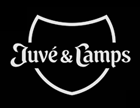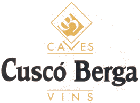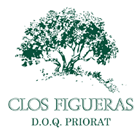Vegalfaro
by
Kathy and Terry Sullivan
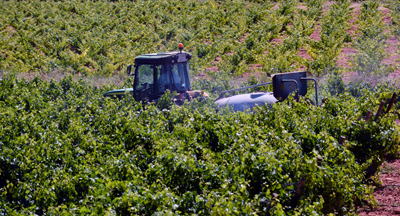 Summary: Located in the province of Valencia, Vegalfaro is in Requena. We met Rodolfo Valiant Garcia winemaker and enthusiastic owner of Vegalfaro. He is also skilled with sabering cava bottles.
Summary: Located in the province of Valencia, Vegalfaro is in Requena. We met Rodolfo Valiant Garcia winemaker and enthusiastic owner of Vegalfaro. He is also skilled with sabering cava bottles.
Vegalfaro is located in Requena in the province of Valencia. We met Rodolfo Valiente Garcia who is the friendly, energetic owner and winemaker at Vegalfaro. The logo for Vegalfaro includes two horses. The design was chosen because of Rodolfo Valiente Garcia’s father who enjoys horses and wine. Rodolfo was eager to share the story of Vegalfaro with us.
Vineyards
We noticed that the vineyards at Vegalfaro stretched out into the bucolic countryside. Thirty-five hectares (86 acres) of organic vineyards are planted in red, clay soil on the Vegalfaro property close to the winery and tasting facility. On a hillside near the ends of vineyard rows, a large, tiled viewing area extends out towards the vines allowing wine tourists to view the prolific green grapevines in the glistening sun. Varieties in the vineyards include: Merlot, Bobal, Cabernet Sauvignon, Chardonnay and Macabeo. A tractor was seen in the vineyard busily spraying an organic product on the vines to combat disease.
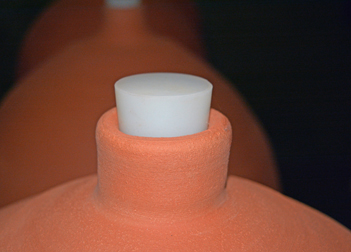 Winery
Winery
After a look at the vineyards, a tour led to the winery production area. A press and several stainless steel tanks filled the one area. Of interest to us was a stainless steel apparatus that washes bottles. Quickly we were escorted to other rooms that were filled with French and Hungarian oak barrels and four amphorae.
Currently in the Vegalfaro winery, Rodolfo is experimenting with the use of amphorae and the Bobal grape variety. Rodolfo is attempting to discern the differences between a Bobal wine aged in oak and Bobal aged in amphorae. In the future he may produce an amphora Bobal. Winemakers may attempt to do this if they want the grape to express itself without an assertion of oak.
Cava bottles are aging in another area. It was noted that the cava aging area is temperature and humidity controlled. It is on ground level rather than several meters below the surface. The winery has a gyropalette for riddling the cava bottles. All cavas are disgorged and corked by hand. The staff can disgorge and cork 400 bottles a day. To ensure freshness, cavas intended for the Christmas holidays are disgorged during the summer.
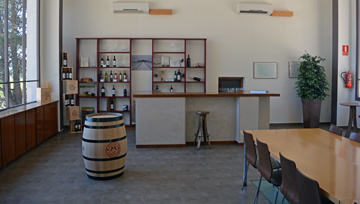 Tasting Room
Tasting Room
Cava tastings are in a large room overlooking the vineyards. Though embraced by many pine trees, the tasting room is bright with a modern feel. The angled ceiling allows a light and airy feeling. Long, angled windows on both sides of the tasting room provide plenty of light for observing what is in your glass. A tasting counter is located at one end of the room. On the opposite side of the room, a stove sits ready to provide warmth when needed. Oak barrels in the room added ambiance. It would be easy to enjoy a couple of hours tasting cavas and wines in the Vegalfaro tasting room. During our tasting, oblong bread sticks and nuts were provided.
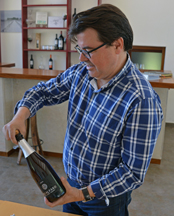 One of the cava labels is Caprasia representing the land of the goats. The back label of the Caprasia 2012, notes that the Iberians treaded grapes and fermented in amphorae in a land called Caprasia, the land of the goats. The wine was then transported throughout the Mediterranean. The label of the Caprasia includes an ornate image decorated with symbols of amphora, ship, grapevine, grape harvest and pressing. The back label says. “In the 5th Century BC the Iberians treaded grapes in two basins carved into the rock for subsequent fermentation in terraces amphoras, located on the ancient site of Las Pilillas - the territory they called Caprasia, ‘The land of the goats.’ The wine was then transported on the River Cabriel to the coast where the Phoenicians shipped the precious nectar to the most flourishing cities of the Mediterranean.”
One of the cava labels is Caprasia representing the land of the goats. The back label of the Caprasia 2012, notes that the Iberians treaded grapes and fermented in amphorae in a land called Caprasia, the land of the goats. The wine was then transported throughout the Mediterranean. The label of the Caprasia includes an ornate image decorated with symbols of amphora, ship, grapevine, grape harvest and pressing. The back label says. “In the 5th Century BC the Iberians treaded grapes in two basins carved into the rock for subsequent fermentation in terraces amphoras, located on the ancient site of Las Pilillas - the territory they called Caprasia, ‘The land of the goats.’ The wine was then transported on the River Cabriel to the coast where the Phoenicians shipped the precious nectar to the most flourishing cities of the Mediterranean.”
Cava and Still Wine
The 2011 Brut Nature Reserva was a blend of 60% Chardonnay and 40% Macabeo. The cava was disgorged in April 2015. The dark yellow colored cava had a slow stream of bubbles rising to the surface forming a small mousse. The cava offered floral, green apple and mineral with a lively mouthfeel. There was mineral and green apple on the finish.
The 2012 Caprasia Brut Nature Reserva was a blend of 50% Chardonnay and 50% Macabeo. It was disgorged in November of 2014. The cava was a dark yellow color and had floral, green apple and mineral notes.
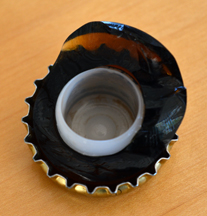 As a special treat, we saw Rodolfo saber a cava bottle that had been riddled but not disgorged. Using the head of a chef’s knife, he followed the seam of the bottle and quickly hit the end. The bottle broke at the end. Only a small tip of the bottle broke off containing the cap, plug and the surrounding glass. Any broken pieces of glass as well as the dead yeast and sediment were propelled from the bottle by the pressure inside. Rodolfo placed the knife on the opening so as not to lose the precious cava. Returning to the tasting room we enjoyed tasting the cava. This 2012 cava offered green apple and mineral. It had a very lively mouthfeel. Rodolfo wants to age it for another year before disgorging it and releasing it to consumers.
As a special treat, we saw Rodolfo saber a cava bottle that had been riddled but not disgorged. Using the head of a chef’s knife, he followed the seam of the bottle and quickly hit the end. The bottle broke at the end. Only a small tip of the bottle broke off containing the cap, plug and the surrounding glass. Any broken pieces of glass as well as the dead yeast and sediment were propelled from the bottle by the pressure inside. Rodolfo placed the knife on the opening so as not to lose the precious cava. Returning to the tasting room we enjoyed tasting the cava. This 2012 cava offered green apple and mineral. It had a very lively mouthfeel. Rodolfo wants to age it for another year before disgorging it and releasing it to consumers.
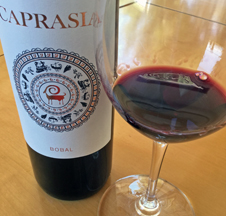 We also tasted a still wine. The Caprasis Bobal was aged in 75% oak and 25% amphora. It was a dark ruby to purple color. The aroma had notes of plums and very ripe blackberries. There were plums, ripe blackberries and licorice on the taste. The wine had bold tannins and was full bodied. There was a hint of sweetness with 2.4 grams per liter of residual sweetness. The wine was 15% alcohol.
We also tasted a still wine. The Caprasis Bobal was aged in 75% oak and 25% amphora. It was a dark ruby to purple color. The aroma had notes of plums and very ripe blackberries. There were plums, ripe blackberries and licorice on the taste. The wine had bold tannins and was full bodied. There was a hint of sweetness with 2.4 grams per liter of residual sweetness. The wine was 15% alcohol.
Wine Tourism
When traveling and visiting the historic town of Requena be sure to add Vegalfaro to your itinerary.
Vegalfaro
Ctra. Pontón-Utiel, Km 3
46340 Requena
(Valencia), Spain
Article written June 2015
Please support the following.
 |
|||
 |
 |
